|
|
|
marfknox
SFN Die Hard

USA
3739 Posts |
 Posted - 10/19/2007 : 03:42:09 Posted - 10/19/2007 : 03:42:09





|
bngbuck wrote to me in another thread: You said:
You really should stop before you expose any more of your own ignorance. Warhol's work was never near photographic realism
(Emphasis mine)

This looks kinda like a photo, you know, what with the really good drawing and all!
Educate me! |
First, I don't think this print looks anything like a photograph. It looks like what it is - a pop art representation of a well known brand name can of soup. Pop art is marked by imitation of commercial illustrations, either in style or by copying exactly.
Photorealism is its own genre. You can read all about it in books or art encyclopedias (or wikipedia online.) Photorealism uses a photograph as a reference and attempts to represent the image in paint with the look of the photograph. The effect, if truly successful, is usually rather jaw-dropping with regard to technique, opposed to pop art which is much more cartoonish and simplified. Charles Bell is a famous photorealist. Compare this painting, which includes some illustrative and pop-like elements, by Bell to Warhol's soup can:

Warhol's soup can might be a very sharp illustration, but it is clearly an illustration and would never be confused with a photograph. Bell's image, on the other hand, uses lighting, perspective, and incredibly high resolution of detail to make an image that in digital form or printed in a magazine would be confused with photographs.
Another great example of a master of photorealm: Chuck Close. WHen I saw one of his 10 foot portraits in the Akron Art museum as kid I was amazed. After reading the label that said "paint on canvas" I kept getting close up, trying to see paint strokes, but could see none. The surface was absolutely smooth. It was truly breathtaking.
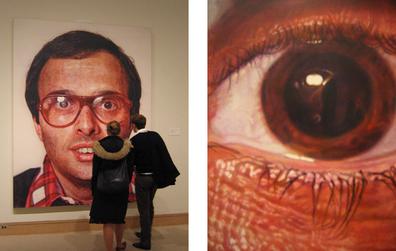
|
"Too much certainty and clarity could lead to cruel intolerance" -Karen Armstrong
Check out my art store: http://www.marfknox.etsy.com
|
Edited by - marfknox on 10/19/2007 03:44:28
|
|
|
Gorgo
SFN Die Hard

USA
5311 Posts |
Posted - 10/19/2007 : 04:06:53 [Permalink]



|
| Wow |
I know the rent is in arrears
The dog has not been fed in years
It's even worse than it appears
But it's alright-
Jerry Garcia
Robert Hunter
|
 |
|
|
Dave W.
Info Junkie

USA
26034 Posts |
|
|
HalfMooner
Dingaling

Philippines
15831 Posts |
Posted - 10/19/2007 : 08:03:37 [Permalink]



|
That is amazing, Dave.
Only in the final closeup at the linked page (if you look very carefully) you will see that the skin texture is very slightly unnatural. There are no real funnel-like pores on and around the nose, where they are most noticeable in life, only a very fine, "hummocky" texture at the finest detail level. But one might never look to notice this, if one thought it was a photograph.
|
“Biology is just physics that has begun to smell bad.” —HalfMooner
Here's a link to Moonscape News, and one to its Archive. |
| Edited by - HalfMooner on 10/19/2007 08:15:59 |
 |
|
|
marfknox
SFN Die Hard

USA
3739 Posts |
Posted - 10/19/2007 : 09:00:16 [Permalink]





|
Technique has an interesting place in art. Anyone who has taken a few higher level art classes will realize that while specific techniques can be taught to pretty much anyone with good eye to hand coordination and fine motor control, creativity with regards to composition, meaning, and visually tying things all together can't really be taught. Like art appreciation, it is something people can both have naturally and develop.
One important thing to know about art history is that the reason non-realistic art has been so big in the last century and a half is because of the invention of the camera. Once we had a machine that could represent reality better than most artists after years of training, the purpose of documentary and illustrative artwork radically changed. The best photorealists work rather like machines. Chuck Close would grid out his canvas and paint each tiny section individually. If one is trying to accurately copy an image created by a machine, one can't be at all expressive or imaginative. All is technique and craft. There's something sort of maddening about oil or acrylic painting like that, opposed to the fast process used by the people Dave linked to. Here sits something that someone spent hours and hours creating that already existed as a simple photograph. Photorealism is very much about an idea, and it is culturally significant for that reason, just like pop art and Pollack's drip paintings. |
"Too much certainty and clarity could lead to cruel intolerance" -Karen Armstrong
Check out my art store: http://www.marfknox.etsy.com
|
 |
|
|
Gorgo
SFN Die Hard

USA
5311 Posts |
Posted - 10/19/2007 : 09:49:05 [Permalink]



|
| Very interesting Marf, thanks. |
I know the rent is in arrears
The dog has not been fed in years
It's even worse than it appears
But it's alright-
Jerry Garcia
Robert Hunter
|
 |
|
|
Dave W.
Info Junkie

USA
26034 Posts |
 Posted - 10/19/2007 : 10:58:10 [Permalink] Posted - 10/19/2007 : 10:58:10 [Permalink]




|
Originally posted by marfknox
If one is trying to accurately copy an image created by a machine, one can't be at all expressive or imaginative. All is technique and craft. |
And some of us artistic know-nothings would ask, "then what makes it 'art'?" If making copies of an image in a different medium from the original is "art," then Xerox machines are artists. You say, "Photorealism is very much about an idea..." but I - for one - don't understand what that means.
On the other hand, Dru Blair's interest is primarily in aircraft, and Tica seems to have been an outlier for him. But in much of his work, such as "Pearl Harbor 0755," or "Timing is Everything," or "Let Nature Take Its Course," Blair is putting things together in a photorealistic painting which would almost never be seen in an actual photo. That certainly makes those works much more than mere copying. |
- Dave W. (Private Msg, EMail)
Evidently, I rock!
Why not question something for a change?
Visit Dave's Psoriasis Info, too. |
 |
|
|
bngbuck
SFN Addict

USA
2437 Posts |
Posted - 10/19/2007 : 21:15:02 [Permalink]



|
Marfknox.....
Tell us about John De Andrea, Marf.
Bill Buck |
 |
|
|
bngbuck
SFN Addict

USA
2437 Posts |
Posted - 10/19/2007 : 21:22:37 [Permalink]



|
Dave W.....(or Marf...?)
What is Dru Blair's actual technique, Dave? Or Marf?
How does he create his images?
This stuff is fascinating!
Bill Buck |
 |
|
|
Dave W.
Info Junkie

USA
26034 Posts |
 Posted - 10/19/2007 : 22:04:20 [Permalink] Posted - 10/19/2007 : 22:04:20 [Permalink]




|
Originally posted by bngbuck
What is Dru Blair's actual technique, Dave? Or Marf?
How does he create his images? |
Blair offers classes on that subject, at $500 a pop (all scheduled workshops on realism are filled). But on Tica's page (linked to above), he does say this:Subtle nuances created by an xacto knife, an eraser, and some colored pencil can build convincing skin texture. The etcetera technique also helps the believability of the skin and hair texture. Fine hair is created using my shield-reveal technique, and my split frisket technique. Airbrush constitutes about 99% of the image. Perhaps finding the back-issue of Airbrush Action magazine with Tica on the cover would give some insight into what those techniques are without having to ante up half a grand.
In other words, I don't have a freakin' clue. |
- Dave W. (Private Msg, EMail)
Evidently, I rock!
Why not question something for a change?
Visit Dave's Psoriasis Info, too. |
 |
|
|
marfknox
SFN Die Hard

USA
3739 Posts |
Posted - 10/19/2007 : 22:42:03 [Permalink]





|
Dave wrote: | And some of us artistic know-nothings would ask, "then what makes it 'art'?" |
Personally, I hate that question. I hate it because I'm sick of it. Art doesn't have a simple definition, and it doesn't have one definition. The meaning changes depending on the context and usage.
In the case of a photorealistic painting which does not deviate from the original photographic image it's a friggin' painting that someone who calls themselves an artist has presented in an art gallery or other artistic venue (presumably invited by a art dealer or curator) to the public to be evaluated and appreciated as art.
Okay, I also hate the question about what makes it art because I am so tired of people confusing what is art with what is good art. If it is presented as art, it is art. If someone shits on a stick and sticks it in a gallery with a label, it is art. If a child scribbles on a paper and says "Hey look at my drawing." it is art. Why do I take this stance? Because it those things aren't art, then what are they? Isn't it a waste of our time to argue about what art is when what we really want to argue about is weather this thing (art or not) has much value or merit?
| If making copies of an image in a different medium from the original is "art," then Xerox machines are artists. |
Comparing a sentient being with intention to a machine? I don't see how that is a valid comparison. Xerox machines are a tool, just like a paintbrush is a tool. Artists can and have used Xerox machines to make art, but for something to be art you need an artist.
| You say, "Photorealism is very much about an idea..." but I - for one - don't understand what that means. |
Whether you love it or hate it, think it is important or think it is frivolous, photorealism has been established as a notable artistic movement. It was just one in a series of movements that has been a backlash against nonrepresentational styles of modern art. It's meaning is dependant on the historical context that it emerged from.
One way to summarize the idea contained in photorealism could be this: the camera may have made the documentary painter obsolete, but painters still love painting! Lots of them still love painting realistically! So the painters not drawn toward abstraction or highly stylized painting often become neoclassicists (copying the techniques of Renaissance Old Masters) or the other extreme, photorealism. The most extreme photorealism is totally mechanical faithfully reproducing a photographic image with human hands. Perhaps it is a form of satire a form of self dehumanization by going to the motions of the machine which has replaced the painter's purpose and diminished the painter's stature. Perhaps it is and extreme act of ritualistic acceptance of that technology. Regardless of what it means to individual painters and admirers, the idea contained in mechanical photorealism is one answer to this question: now that these cameras have profoundly changed everything, while we still have this giant weight of Western art history on our shoulders, what should painters do?
| On the other hand, Dru Blair's interest is primarily in aircraft, and Tica seems to have been an outlier for him. But in much of his work, such as "Pearl Harbor 0755," or "Timing is Everything," or "Let Nature Take Its Course," Blair is putting things together in a photorealistic painting which would almost never be seen in an actual photo. That certainly makes those works much more than mere copying. |
No doubt that Dru's paintings are more than copying. In fact, they are not photorealistic. At least not in an academic sense. But for the sake of argument, I've already started to use the adjective "mechanical" in front of "photorealism" to mark the photorealistic movement of the 60's and 70's, which indeed was about copying.
But mechanical photorealism is not making a mere copy. There is nothing mere about it! Sure, Chuck Close could have just had a high quality giant photograph printed, but he wanted to paint it, and viewers are that much more astounded when they realize he painted it. Is that not reason enough? What's the point of dancing? What's the point of climbing a mountain? Our whole existence is pretty pointless unless we give it meaning. Mechanical photorealism is real art that much more because it is so utterly useless and needlessly time and effort consuming. Art doesn't nourish your body, protect you from harm, or help you clean the carpet. It is just something we do (if we're the artist) or enjoy (if we're the audience) for its own wonderful sake.
|
"Too much certainty and clarity could lead to cruel intolerance" -Karen Armstrong
Check out my art store: http://www.marfknox.etsy.com
|
| Edited by - marfknox on 10/19/2007 22:46:49 |
 |
|
|
marfknox
SFN Die Hard

USA
3739 Posts |
Posted - 10/19/2007 : 22:47:11 [Permalink]





|
Since coming home tonight I've had a chance to read through that page of Dru Blair's. I found it rather informative, and I agreed with much of what he said, although I intensely disagreed with a couple things (the sentences in bold): As a style, Photorealism has a few detractors, who often dismiss it as pointless, or non-art. They fail to realize that many photorealistic paintings are not mere copies of photographs, but interpretations of reality based on the artist's vision. The act of merely copying a photograph has no artistic merit except to hone one's artistic skills. Most of my aviation paintings would be impossible to photograph, such as Timing is Everything for example. This painting of Tica is not just a copy of a photograph, but is a product of many artistic decisions, whereas I deviated from the reference photo for more aesthetic appeal.
Often, the artist's deviation from the reference material is unconscious. Despite my best efforts, my own unconscious stylization creeps into all of my work, and it is a struggle to keep it subdued.
Photographic reference is almost always used as a guide by photorealists, but becomes less necessary as an artist gains proficiency, and understanding of the elements of photorealism. While reading the list of the elements of realism, consider that no other artistic style demands so much of an artist. Photorealism is by far, the most difficult artistic style to master. |
Some photorealistic paintings - such as Chuck Close painting I posted above and others in that series) are an attempt to copy a photographic image exactly, but these paintings have more artistic merit than just honing the artist's skills.
As for photorealism being the most difficult type of painting, is this guy putting himself above the old masters? Is he saying that what he does, heavily aided by modern technology, is more difficult than what contemporary artists Odd Nerdrum and Jenny Saville are doing (see below)?


I also found this statement of Blair's rather, well, for lack of a better word, obscene: The reason photography does not qualify
as art is that the process removes the filter of the human mind as an interpretative element. Although photography requires technical skill, in the final analysis it is only a mechanical recording of reality. |
Wow. Ansel Adams and Robert Mapplethorpe must be rolling in their graves. Just look what's not art, but only a mechanical recording of reality:
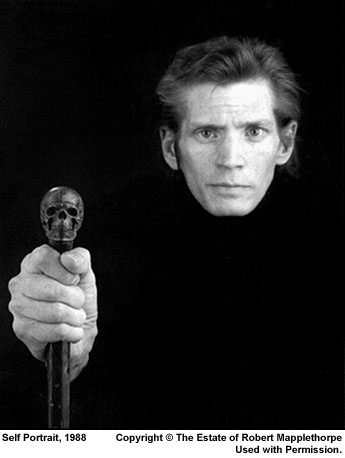
|
"Too much certainty and clarity could lead to cruel intolerance" -Karen Armstrong
Check out my art store: http://www.marfknox.etsy.com
|
| Edited by - marfknox on 10/19/2007 22:48:36 |
 |
|
|
marfknox
SFN Die Hard

USA
3739 Posts |
Posted - 10/19/2007 : 22:54:42 [Permalink]





|
Bngbuck wrote: | Tell us about John De Andrea, Marf. |
Like what? What am I, an encyclopedia?
Besides, I like Duane Hanson better.
 |
"Too much certainty and clarity could lead to cruel intolerance" -Karen Armstrong
Check out my art store: http://www.marfknox.etsy.com
|
 |
|
|
bngbuck
SFN Addict

USA
2437 Posts |
Posted - 10/20/2007 : 01:13:26 [Permalink]



|
Marfknox.....
OK, then tell us what you know about Duane Hansen. I have done the Wiki thing now and four other articles. Because you like Hansen and must know something about his work, I would like to know something about hyperrealism sculpture, as related to photorealism. I lived in Denver most of my life and was always fascinated by Linda, when she was at the museum. I had the pleasure of meeting De Andrea once at the museum, and found him interesting but not very communicative.
I had no idea that Hansen and apparently many others existed, (OK stupid ignorance, etc.)
But I guess what I really am interested in is the 3-D aspect of this kind of sculpture as compared to the planar aspect of photorealism. What little I have been able to glean from a few hours reading has not revealed very much as to how a hyperrealist (if this is the wrong term, correct me) sculptor goes about creating something like Linda, or Tourists.
Actually, because Wiki was hellishly vague about it:
1. Exactly how does a true photorealist produce a finished work of art. (The technique, the logistics, if you will of using a photograph, a canvas, and paint and painting tools to achieve a finished product?
2. How does a hyperrealist sculptor produce a finished Linda or Tourists? Again, the actual steps involved?
Wiki, and several other references talk about transferring a photographic image (presumably in color) to a canvas, and then transforming that image into a painting. The only thing I can imagine is overpainting the photo image. Is this correct?
I can't find anything (don't know where to look) about how a hyperrealist sculptor goes about creating a 3-D form. I can't imagine it involves a photo of any kind, perhaps body molds or the like? How do they do it?
Personally, as an art imbecile, I would not confuse the Bell work you showed above with a photograph. Maybe I would if I saw the original. However,the Chuck Close examples are pretty amazing allright. I am sure there are many more equally impressive!
Having had the astounding experience of being within about four feet (the limit of the electronic security screen) of Linda, there is to me an enormous difference in the perception experience of that 3D 'reality' and what I have seen in reproductions of photorealism art.
Linda, and no doubt Tourists and many others, are palpably real. My tactile sense literally begged me to touch, as well as see that thing. I have seen, close up, several "fresh" corpses in my life. Linda appeared to me definitely more "real". Not alive, but real.
I am not prepared as yet to comment or ask as to how all of this relates to art, whatever that is. But I was tremendously impressed, bemused, and stimulated by the experience.
If you know how both the two dimensional representation of photographs is done (photorealism), and the three dimensional rendering of a human body is done (hyperrealistic sculpture, for lack of a better term), I would really appreciate your either explaining it or referring me to a web source that gives all the details. |
 |
|
|
recurve boy
Skeptic Friend

Australia
53 Posts |
 Posted - 10/20/2007 : 03:39:00 [Permalink] Posted - 10/20/2007 : 03:39:00 [Permalink]



|
Originally posted by bngbuck
Marfknox.....
....
1. Exactly how does a true photorealist produce a finished work of art. (The technique, the logistics, if you will of using a photograph, a canvas, and paint and painting tools to achieve a finished product?
2. How does a hyperrealist sculptor produce a finished Linda or Tourists? Again, the actual steps involved?
|
What is she? An encyclopaedia?
Seriously, your answer would require a book. There are probably as many styles and techniques to produce a photorealistic painting as artists. |
 |
|
|
marfknox
SFN Die Hard

USA
3739 Posts |
Posted - 10/20/2007 : 08:45:42 [Permalink]





|
bngbuck wrote: | 1. Exactly how does a true photorealist produce a finished work of art. (The technique, the logistics, if you will of using a photograph, a canvas, and paint and painting tools to achieve a finished product? |
recurve boy is correct there are many techniques for making a photorealistic painting or hyperrealistic sculpture.
| Wiki, and several other references talk about transferring a photographic image (presumably in color) to a canvas, and then transforming that image into a painting. The only thing I can imagine is overpainting the photo image. Is this correct? |
No. Transferring refers to drawing the image on another surface, sometimes by using the grid method, sometimes by projecting the photo onto the canvas and tracing. There are other methods, but grid and projection are the most common. This is also how murals are typically created the artist does a small version and then transfers it onto a larger wall.
| I can't find anything (don't know where to look) about how a hyperrealist sculptor goes about creating a 3-D form. I can't imagine it involves a photo of any kind, perhaps body molds or the like? How do they do it? |
There are different ways. Duane Hanson does molds of actual people. Here's an article from USA Today on his career: http://findarticles.com/p/articles/mi_m1272/is_2648_127/ai_54680895/print
| In the late 1960s. Hanson began to experiment with direct casting from a human form. Using synthetic resins, he made a mold from the body and used it to cast a three-dimensional sculpture. Each figure was cast in several sections before being joined together. Hanson then painted the surface in careful detail and added the necessary accessories and props. Although he would experiment with other methods and media, Hanson used direct casting for the duration of his career. |
Linda, and no doubt Tourists and many others, are palpably real. My tactile sense literally begged me to touch, as well as see that thing. I have seen, close up, several "fresh" corpses in my life. Linda appeared to me definitely more "real". Not alive, but real.
I am not prepared as yet to comment or ask as to how all of this relates to art, whatever that is. |
You just did in the above paragraph. It reads a lot like an art review.
The techniques for making those sculptures were developed by those artists themselves. Beyond casting (for sculpture) and grid or projection transfer (for paintings) the rest is pure skill, training, and practice. Take someone like Chuck Close I've seen pictures of him working in his studio. Go to a book store or library and flip through a book on him and you'll probably find such a photo. Then you can see just how tiny the sections in his grid are. Imagine breaking up a photo of someone's face into, say, 100,000 tiny squares. (I don't actually know how many sections are typically in Close's grids). Then imagine that when you paint each tiny section, you are only looking at that section, probably blown up to being larger than the section you are painting so that you can really see all the abstract details. Your goal is purely to get all the shades, hues, and proportions of marks exact. This is no longer a face. This is all lines, shapes, textures, colors, and values. You are like a machine, intent on creating a specific product.
Duane Hanson and hyperrealistic sculptures are pretty different. I like Hanson personally 'cause he has a social conscious and inserts it into his work in a way that I think were genuinely provocative and moving. He lived through the Vietnam era and made work about the atrocities of war.
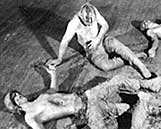 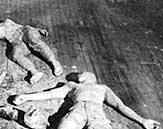
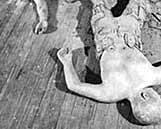 
There are art-historical similarities to photorealism in the USA Today article Hanson talks about becoming an artist at the height of abstract expressionism, and says: | "I would try to do abstract work, but I always put a bit of an arm or nose in it. I never could do just nonfigurative work." |
Anyway, back to how he does it
that's like trying to explain how Odd Nerdrum or Jenny Saville make their paintings. Or Rembrandt, for that matter. You can learn some basic techniques for perspective, color theory, proportioning, but when it comes down to it, a lot of it is intuitive understanding that comes from both natural talent and years of training and practice. Duane Hanson can cast body parts and put them together, which his a nice short cut to dealing with body proportions and realistic details of form, but then he has to put them together, arrange the overall composition, and probably hardest of all, paint everything to look real. How does a mortician reconstruct a damaged face of a corpse and then paint it to look as lifelike as possible? There aren't simple answers to these questions because it isn't a mechanical process. These people are just good at what they do!
|
"Too much certainty and clarity could lead to cruel intolerance" -Karen Armstrong
Check out my art store: http://www.marfknox.etsy.com
|
 |
|
 |
|
|
|
![]()